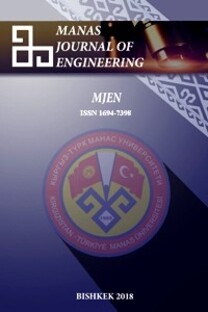Environmental pollution size of the Bishkek Solid Waste Landfill and treatment of generated leachate wastewater
Environmental pollution size of the Bishkek Solid Waste Landfill and treatment of generated leachate wastewater
___
- [1]. Iskander S.Md., Zhao R., Pathak A., Gupta A., Pruden A., Novak J.T., He Z., “A review of landfill leachate induced ultraviolet quenching substances: Sources, characteristics, and treatment”, Water Research, 145 (2018) 297-311.
- [2]. Renou S., Givaudan J., Poulain S., Dirassouyan F., Moulin P., “Landfill leachate treatment: review and opportunity”, J. Hazard. Mater. 150 (2008) 468–493.
- [3]. Kurniawan T. A., Waihung Lo., Chana G., Mika E. T. Sillanpaa., “Biological processes for treatment of landfill leachate”, Journal of Environmental Monitoring, 2010, 12, 2032–2047.
- [4]. Foo K.Y., Hameed B.H., “An overview of landfill leachate treatment via activated carbon adsorption process”, Journal of Hazardous Materials 171 (2009) 54–60.
- [5]. Gao J., Oloibiri V., Chys M., Audenaert W., Decostere B., He Y., Langenhove H.V., Demeestere K., Hulle S.W.H.V., “The present status of landfill leachate treatment and its development trend from a technological point of view”, Rev Environ Sci Biotechnology, 14 (2015) 93–122.
- [6]. Ahmed F.N., Lan C.Q., “Treatment of landfill leachate using membrane bioreactors: A review”, Desalination, 287, (2012), 41-54.
- [7]. Zhang Q.Q., Tian B.H., Zhang X., Ghulam A., Fang C.R., He R., “Investigation on characteristics of leachate and concentrated leachate in three landfill leachate treatment plants”, Waste Management, 33 (2013) 2277– 2286.
- [8]. Gautam P., Kumar S., Lokhandwala S., “Advanced oxidation processes for treatment of leachate fromhazardous waste landfill: A critical review”, Journal of Cleaner Production, 237 (2019) 117639.
- [9]. Mandal P., Dubey B.K., Gupta A.K., “Review on landfill leachate treatment by electrochemical oxidation: Drawbacks, challenges and future scope”, Waste Management, 69 (2017) 250-273.
- [10]. APHA (2005) Standard Methods for the Examination of Water and Wastewater. 21st Edition, American Public Health Association/American Water Works Association/Water Environment Federation, Washington DC.
- [11]. Fleck E., Gewehr A.G., Cybis L.F.A., Gehling G.R., Juliano V.B., “Evaluation of the treatability of municipal waste landfill leachate in a SBR and by coagulationflocculation on a bench scale”, Brazilian Journal of Chemical Engineering, 33 (2016) 851-861.
- [12]. Long Y., Xu J., Shen D., Du Y., Feng H., “Effective removal of contaminants in landfill leachate membrane concentrates by coagulation”, Chemosphere, 167 (2017) 512-519.
- [13]. Orescanin V., Ruk D., Kollar R., Mikelic I.L.,Nad K., Mikulic N., “A combined treatment of landfill leachate using calciumoxide, ferric chloride and clinoptilolite”, J. Environ. Sci. Health A, 46 (2011) 323-328.
- [14]. Maranon E., CastrillonL., Fernandez-Nava Y., Fernandez-Mendez A., Fernandez-Sanchez, A., “Coagulation–flocculation as a pretreatment process ata landfill leachate nitrification–denitrification plant”, J. Hazard. Mater., 156 (2008) 538-544.
- [15]. Garcia-Segura S., Ocon J.D., Chong M.N., “Electrochemical oxidation remediation of realwastewater effluents-A review”, Process Safety and Environmental Protection, 113 (2018) 48-67.
- [16]. Anglada A., Urtiaga A., Ortiz I., Mantzavinos D., Diamadopoulos E., “Boron-doped diamond anodic treatment of landfill leachate:Evaluation of operating variables and formation of oxidationby-products”, Water Research, 45 (2011) 828-838.
- [17]. FernandesA., PachecoM.J., CiríacoL., LopesA., “Review on the electrochemical processes for the treatment of sanitarylandfill leachates: Present and future”, Applied Catalysis B, 176 (2015) 183-200.
- ISSN: 1694-7398
- Yayın Aralığı: 2
- Başlangıç: 2001
- Yayıncı: KIRGIZİSTAN-TÜRKİYE MANAS ÜNİVERSİTESİ
Training of the feed-forward artificial neural networks using butterfly optimization algorithm
Study on antimony cake as a technogenic raw material for the production of antimony oxides
Damira Sambaeva, Kubat Kemelov, Zarlyk Maimekov, Zhyldyz Tunguchbekova, Uran Maimekov
Fitting the Itô Stochastic differential equation to the COVID-19 data in Turkey
Fevzi Erdoğan, Sevda Özdemir Çalıkuşu
Zarlyk MAİMEKOV, Zhyldyz TUNGUCHBEKOVA, Kubat KEMELOV, Uran MAİMEKOV, Damira SAMBAEVA
İsmet ALTINTAŞ, Arzıgul İMANKULOVA
Şeyma Yavuz, Pelin Güngör Yeşilova
Sahin DEMİRCİ, Betul ARİ, Sultan B. SENGEL, Erk INGER, Nurettin SAHİNER
